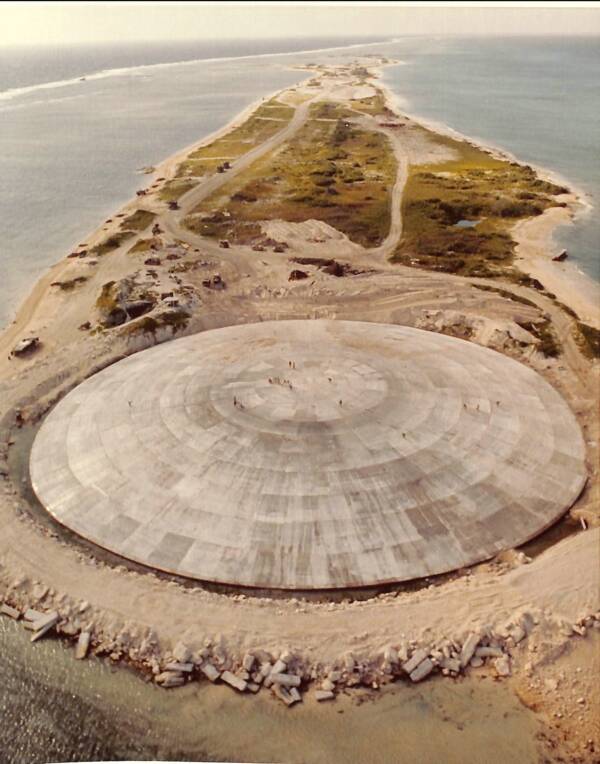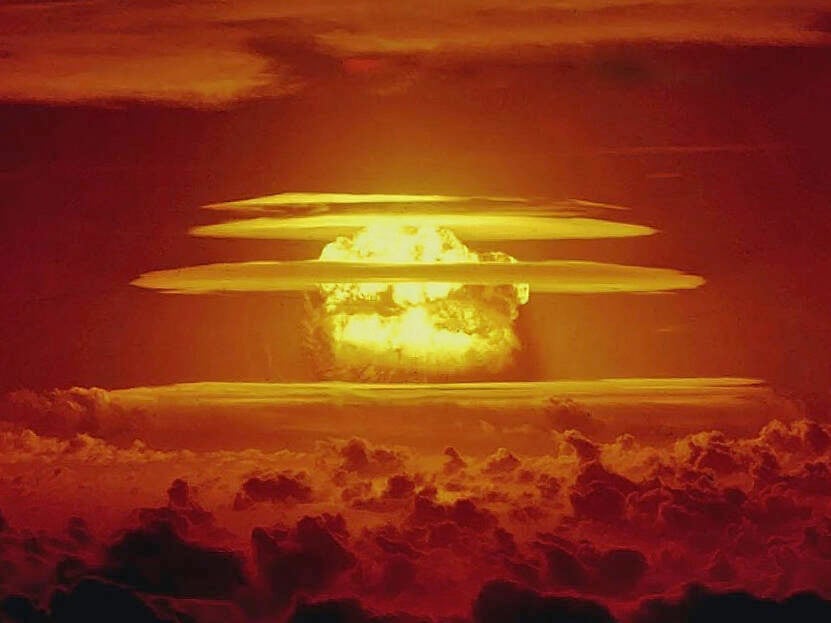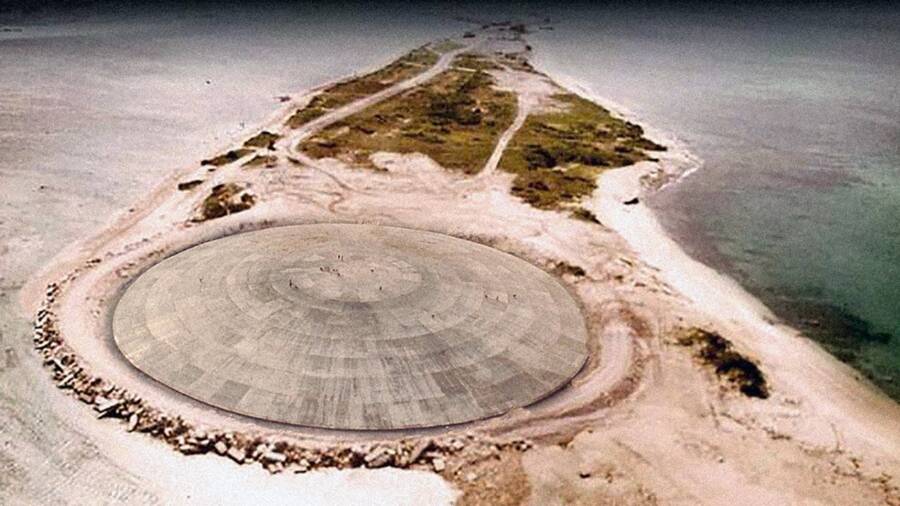The Runit Dome was constructed between 1977 and 1980 in order to contain radioactive waste from America’s Cold War nuclear tests — but it’s begun to crack.

Public DomainThe Runit Dome was built to contain nuclear waste, but some experts warn that it’s in danger of falling apart.
The Marshall Islands is a picturesque island nation tucked in the Pacific Ocean between Hawaii and the Philippines. But among its coconut trees and crystal-clear waters is a huge concrete dome. The so-called Runit Dome stems from the nation’s past as a nuclear testing site for the United States — and holds very real dangers for present and future inhabitants.
Between 1946 and 1958, the United States detonated 67 nuclear and atmospheric bombs on Enewetak Atoll and Bikini Atoll in the Marshall Islands. Looking to gain an advantage over the Soviet Union in the Cold War, the United States used the island nation as a testing site, dropping not only nuclear bombs, but biological weapons as well.
In the 1970s, the U.S. attempted to clean up the hazardous byproducts of its testing by burying them under an 18-inch thick concrete dome on Runit Island in the Enewetak Atoll, known as the Runit Dome, the Cactus Dome, or simply “The Tomb.” This temporary solution has become long-term, and many fear an ecological disaster as the structure starts to age.
The Marshall Islands As A U.S. Nuclear Test Site
The story of the Runit Dome starts in the 1940s, when the U.S. identified the Marshall Islands as a suitable site for testing nuclear weapons. This calculation, according to The Guardian, was made based on the nation’s low population and distance from other countries and shipping lanes.
In 1946, the United States dropped its first nuclear bomb on the islands. Over the next five years, eight more nuclear bombs — ranging from 23 to 225 kilotons — were detonated near both Enewetak Atoll and Bikini Atoll.

Public DomainThe Castle Bravo explosion at Bikini Atoll in the Marshall Islands. March 1, 1954.
In 1952, the American government started testing larger weapons. According to the Los Angeles Times, it dropped 25 nuclear bombs over the next four years, including a bomb called Castle Bravo which was 1,000 times more powerful than the bombs dropped on Hiroshima and Nagasaki. It stands as the most powerful hydrogen bomb ever detonated by the U.S.
The pace of nuclear detonations only accelerated in the late 1950s, as American authorities worried about bans on above-ground testing. In 1958 alone, 33 bombs were dropped between April 28 and August 18.
But even after the Limited Test Ban Treaty was signed in 1963, the U.S. continued to test weapons on the Marshall Islands — just not nuclear ones. Starting in 1968, dozens of biological weapons were tested as well.
By the 1970s, the U.S. had exhausted its need for testing weapons on the Marshall Islands. Decades of explosions, however, had battered the once edenic landscape, leaving huge craters, destroying entire islands, and, worst of all, leaving behind tons of radioactive waste.

Wikimedia CommonsMushroom cloud from the dropping of nuclear bomb Ivy King north of Runit Island in 1952.
The U.S. agreed to help clean up the Marshall Islands, which soon led to the construction of a concrete “tomb” on Runit Island dubbed the Runit Dome.
The Dangerous Construction Of The Runit Dome
In 1972, the U.S. agreed to return Enewetak Atoll to its inhabitants after they threatened legal action. According to The New York Times, the U.S. also agreed to clean up the atoll. But the Americans quickly ran into problems.
For starters, there were more than 3.1 million cubic feet of radioactive material on the islands. The atoll’s Runit Island proved especially problematic, as it had been the site of 11 nuclear tests which had left behind “high subsurface contamination.” The radioactive isotopes there had a half-life of 24,000 years — Runit Island would always be toxic for humans.
So, the Atomic Energy Commission, (today’s Department of Energy) and the Department of Defense came up with a plan to collect radioactive debris from across the Enewetak Atoll and dump it into the Runit crater, then cover the whole thing with a concrete dome. Because Congress refused to pay for private contractors, the government tapped U.S. troops to do the job.

Tim SniderYellow radiation suits were quickly abandoned, as they were unrealistic for the harsh heat on Runit Island.
Between 1977 and 1980, some 4,000 U.S. servicemen shoveled 35 Olympic swimming pools’ worth of contaminated soil and debris into the crater. They mixed the debris with concrete, then sealed the so-called Runit Dome with an 18-inch layer of concrete that stretched 377 feet wide.
Though some safety measures were put into place, most were quickly abandoned. The atoll was too hot to wear yellow radiation suits, for example, and air samplers to monitor plutonium intake quickly broke.
“That dust [containing plutonium] was like baby powder. We were covered in it,” Paul Laird, who worked as a bulldozer driver during the construction of the Runit Dome, recounted to The New York Times. “But we couldn’t even get a paper dust mask. I begged for one daily. My lieutenant said the masks were on backorder so use a T-shirt.”
He added: “When the job was done, they threw my bulldozer in the ocean because it was so hot. If it got that much radiation, how the hell did it miss me?”
Laird, and hundreds of other troops who helped build the Runit Dome, later suffered from cancer, bone problems, and even birth defects in their children. But the government has refused to pay for their medical care.

Alan LeemanU.S. troops gathered radioactive debris without protective gear, and hundreds suffered from health problems later in life.
“No one seems to want to admit anything,” veteran Jeff Dean, who has suffered from cancer, bone problems, and mounting medical bills, told The New York Times. “I don’t know how much longer we can wait, we have guys dying all the time.”
Meanwhile, the Runit Dome also poses a threat to Marshallese who have resettled in the southern part of Enewetak Atoll — especially as climate change threatens to damage it and unleash its contents.
The Ongoing Danger Of ‘The Tomb’
For Marshallese, the Runit Dome is a disaster in more ways than one. First of all, it represents the painful history of U.S. nuclear testing. And second of all, it poses a grave danger as the concrete dome begins to age.
Nerje Joseph was a child on Rongelap Atoll when the Castle Bravo detonation took place on March 1, 1954. She told the Los Angeles Times that she remembers the day with “two suns” and how nuclear fallout rained down her home. Though the U.S. evacuated Joseph and others two days later, many people suffered from health problems later in life.

YouTubeSome warn that the Runit Dome is a disaster waiting to happen.
“We had a oneness when we lived on Rongelap,” Joseph, who has suffered from decades of thyroid problems, told the Los Angeles Times. “We worked together, we ate together, we played together. That has been lost.”
Nuclear testing on the Marshall Islands stole Joseph’s past — but it threatens to steal inhabitants’ future, too. The Runit Dome contains 111,000 cubic yards of radioactive debris and experts fear that a storm surge brought on by climate change could catastrophically damage the dome.
Then, its contents might pour into the Pacific Ocean.
“Runit Dome represents a tragic confluence of nuclear testing and climate change,” Michael Gerrard, director of the Sabin Center for Climate Change Law at Columbia University, told The Guardian. “It resulted from US nuclear testing and the leaving behind of large quantities of plutonium.”
In 2019, the U.S. announced that they intended to extend an agreement with the Marshall Islands to provide aid in exchange for military privileges on the territory. But the Runit Dome continues to be an open wound.
“These are matters of life and death for us,” Jack Ading, a Marshallese senator from Enewetak Atoll told the Los Angeles Times. “We can’t afford to rely exclusively on reassurances from one source. We need neutral experts from the international community to weigh in.”
He added: “We didn’t know the Runit Dome waste dump would crack and leak… We didn’t know about climate change. We weren’t nuclear scientists who could independently verify what the U.S. was telling us. We were just island people who desperately wanted to return home.”
After learning about Runit Dome, read the story of Tsar Bomba, the Soviet warhead that was too powerful to use. Then, discover the story of the Hiroshima shadows.





